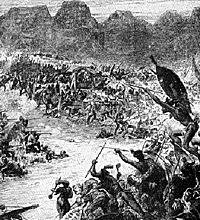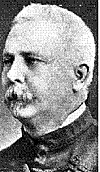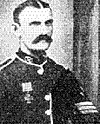During the Zulu war of 1879, British troops had marched deep into Zulu land. The British constructed forts to guard their lines of communications with the Natal colony. Periodically, convoys were dispatched to supply these garrisons.
 Gallant British soldiers fighting the Zulus
Gallant British soldiers fighting the Zulus
In late February of 1880, a convoy of twenty wagons contain-ing supplies left, but owing to the bad state of the roads after heavy rains, suffered breakdowns and delays. Flooding over the Intombi River had finally brought it to a halt. Captain Moriarty's H Company with a wagonload of materials for building a raft was ordered to bring the convoy in.
When Moriarty reached the Intombi, he found that one wagon which had been bogged down in the drift had been pulled out, but that a further six on the far, north bank were unable to cross as the river was high. Having constructed a raft, and leaving a junior officer with thirty-four men on the south bank, Moriarty crossed the river on the following day with the rest of his company. The continued rain, however, made any crossing impossible, so he formed a V-shaped laager on the north bank with the open end on the river. The rain continued until the afternoon of the next day. Moriarty's laager was not formed up well, for the wagons were not locked up tightly, and there were gaps between the end wagons of the V and the river, owing to the floodwater having fallen. Moriarty hoped to get the wagons across on the next day and the possibilities of an enemy attack seemed remote. Despite the thick bush surrounding the area, Moriarty posted no outlying sentries having only single sentries on either side of the laager. As there was only an N.C.O., Colour-Sergeant Booth, with the 34-strong detachment on the south bank, Moriarty ordered his junior officer, Lieutenant Harward to take command on the other side of the river.
 Zulu warrior in full battle regalia.
Zulu warrior in full battle regalia.
At 3.30 a.m., one of Harward's sentries heard a shot to the north. Harward stood his men to and sent a message across the river to warn Moriarty, but the latter, after warning his sentries to be on the alert, went back to sleep. At first light around 5 a.m., with the morning mist clearing, the sentry on the south bank suddenly saw a body of about 800 Zulus encircling the wagon laager. He raised the alarm, which was taken up by the sentries on the north bank. The troops immediately fell out, but before the soldiers could man their posts the Zulus were in the laager, stabbing at the men as they stumbled from their tents. Moriarty found himself surrounded.
 The unfortunate Captain Moriarty
The unfortunate Captain Moriarty
Crying out "Death or glory"! "Fire away, boys! For I am done"! Within moments all the eighty-odd soldiers, and Wagoner's in the laager had been killed save for twelve men who managed to make it to the river.
On the south bank Harward's troops had opened fire across the river. A party of 200 Zulus had already crossed higher upriver and advanced rapidly to attack the soldiers on the South bank. Harward's detachment was quickly broken.
 Color Seargent Booth
Color Seargent Booth
Telling Colour-Sergeant Booth to retreat to a farmhouse a mile away, he galloped off to Luneburg to fetch help. Booth managed to assemble a dozen or so men and steadily retreated, holding off the Zulus with steady volleys. Harward finally arrived with reinforcements and came upon Colour Sergeant Booth and his small party. On approaching the river all that could be seen were the Zulus heading off with loot taken from the wagons. With the exception of a soldier and two native workers who had been hiding, the rest of the command had been wiped out. Out of a strength of 106, 79 had been killed or were missing. For his brave and steady conduct during the fighting, Colour-Sergeant Booth was awarded the Victoria Cross. Harward was tried by general court martial for abandoning his men in the face of the enemy.
Back to SJCW The Volunteer Spring 2000 Table of Contents
Back to SJCW The Volunteer List of Issues
Back to Master Magazine List
© Copyright 1999 by SJCW
This article appears in MagWeb (Magazine Web) on the Internet World Wide Web.
Other military history articles and gaming articles are available at http://www.magweb.com